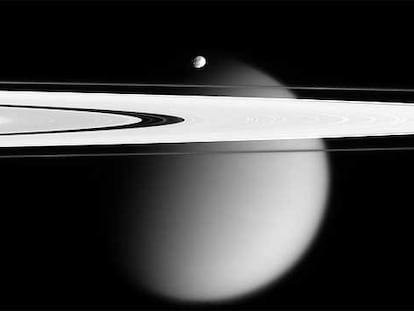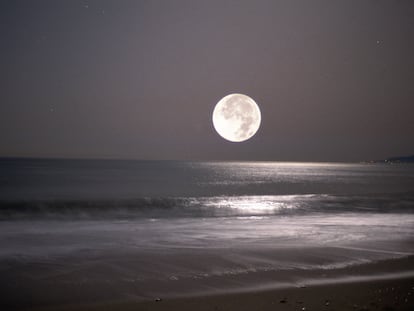Saturn’s Death Star-looking moon may have vast underground ocean
The ocean is believed to fill half of Mimas’ volume. Yet it represents only 1.2% to 1.4% of Earth’s oceans given the moon’s petite size

Astronomers have found the best evidence yet of a vast, young ocean beneath the icy exterior of Saturn’s Death Star lookalike mini moon.
The French-led team analyzed changes in Mimas’ orbit and rotation and reported Wednesday that a hidden ocean 12 to 18 miles (20 to 30 kilometers) beneath the frozen crust was more likely than an elongated rocky core. The scientists based their findings on observations by NASA’s Cassini spacecraft, which observed Saturn and its more than 140 moons for more than a decade before diving through the ringed planet’s atmosphere in 2017 and burning up.
Barely 250 miles (400 kilometers) in diameter, the heavily cratered moon lacks the fractures and geysers — typical signs of subsurface activity — of Saturn’s Enceladus and Jupiter’s Europa.
“Mimas was probably the most unlikely place to look for a global ocean — and liquid water more generally,” co-author Valery Lainey of the Paris Observatory said in an email. “So that looks like a potential habitable world. But nobody knows how much time is needed for life to arise.” Results were published in the journal Nature.
The ocean is believed to fill half of Mimas’ volume, according to Lainey. Yet it represents only 1.2% to 1.4% of Earth’s oceans given the moon’s petite size. Despite being so small, Mimas boasts the second largest impact crater of any moon in the solar system — the reason it’s compared to the fictional Death Star space station in “Star Wars.”
“The idea that relatively small, icy moons can harbor young oceans is inspiring,” SETI Institute’s Matija Cuk and Southwest Research Institute’s Alyssa Rose Rhoden wrote in an accompanying editorial. They were not part of the study.
Believed between 5 million and 15 million years old, too young to mark the moon’s surface, this subterranean ocean would have an overall temperature right around freezing, according to Lainey. But at the seafloor, he said the water temperature could be much warmer.
Co-author Nick Cooper of Queen Mary University of London said the existence of a “remarkably young” ocean of liquid water makes Mimas a prime candidate for studying the origin of life.
Discovered in 1789 by English astronomer William Herschel, Mimas is named after a giant in Greek mythology.
Sign up for our weekly newsletter to get more English-language news coverage from EL PAÍS USA Edition
Tu suscripción se está usando en otro dispositivo
¿Quieres añadir otro usuario a tu suscripción?
Si continúas leyendo en este dispositivo, no se podrá leer en el otro.
FlechaTu suscripción se está usando en otro dispositivo y solo puedes acceder a EL PAÍS desde un dispositivo a la vez.
Si quieres compartir tu cuenta, cambia tu suscripción a la modalidad Premium, así podrás añadir otro usuario. Cada uno accederá con su propia cuenta de email, lo que os permitirá personalizar vuestra experiencia en EL PAÍS.
¿Tienes una suscripción de empresa? Accede aquí para contratar más cuentas.
En el caso de no saber quién está usando tu cuenta, te recomendamos cambiar tu contraseña aquí.
Si decides continuar compartiendo tu cuenta, este mensaje se mostrará en tu dispositivo y en el de la otra persona que está usando tu cuenta de forma indefinida, afectando a tu experiencia de lectura. Puedes consultar aquí los términos y condiciones de la suscripción digital.
More information
Archived In
Últimas noticias
A floating school teaches children how to save Lake Atitlán
Pablo Escobar’s hippos: A serious environmental problem, 40 years on
From Andorra to Gibraltar, a black market for Ozempic exploits its success: ‘They’re the most sought-after products in the world’
The brief rise and retreat of Generation Z in Mexico
Most viewed
- Why we lost the habit of sleeping in two segments and how that changed our sense of time
- Charles Dubouloz, mountaineering star, retires at 36 with a farewell tour inspired by Walter Bonatti
- Venezuela faces its most tense Christmas yet
- CBS in crisis after pulling a report on Trump’s deportations to El Salvador (which later leaked online)
- Bukele clan fumes over investigation exposing their new wealth










































